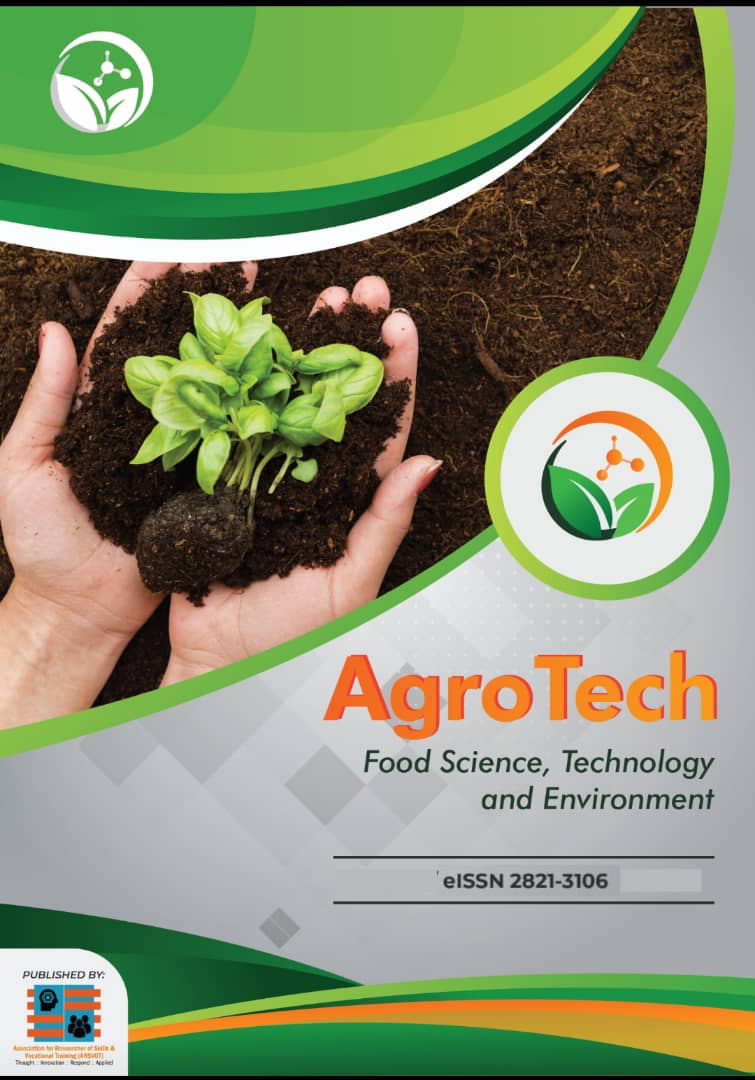Improving Yield Through Biochar Application in Kailan (Brassica oleracea var. alboglabra) Cultivation
DOI:
https://doi.org/10.53797/agrotech.v2i1.6.2023Keywords:
biochar, kailan, rice husk, sustainable agriculture, vegetable yield, BrassicaAbstract
The increasing demand for leafy vegetables in Malaysia necessitates sustainable agricultural innovations to improve soil health and crop yield. This study evaluates the effects of rice husk biochar application at different rates (0, 10, and 20 t/ha) on the growth and yield of Kailan (Brassica oleracea var. alboglabra). A field experiment using randomized complete block design with four replications was conducted, assessing plant height, diameter, number of leaves, fresh weight, and total yield. Results demonstrated significant improvements in all growth parameters and yield with increasing biochar rates. These findings reinforce the potential of biochar as a sustainable amendment for enhancing vegetable production.
Downloads
References
Agegnehu, G., Bass, A. M., Nelson, P. N., & Bird, M. I. (2016). Benefits of biochar, compost and biochar–compost for soil quality, maize yield and greenhouse gas emissions in a tropical agricultural soil. Science of the Total Environment, 543, 295–306. https://doi.org/10.1016/j.scitotenv.2015.11.054
Agegnehu, G., Srivastava, A. K., & Bird, M. I. (2017). The role of biochar and biochar-compost in improving soil quality and crop performance: A review. Applied Soil Ecology, 119, 156–170. https://doi.org/10.1016/j.apsoil.2017.06.008
El-Naggar, A., Lee, S. S., Rinklebe, J., Farooq, M., Song, H., Sarmah, A. K., ... & Ok, Y. S. (2019). Biochar application to low fertility soils: A review of current status, and future prospects. Geoderma, 337, 536–554. https://doi.org/10.1016/j.geoderma.2018.09.034
FAO. (2021). The State of Food and Agriculture 2021: Making agrifood systems more resilient to shocks and stresses. Food and Agriculture Organization of the United Nations. https://doi.org/10.4060/cb4476en
Glaser, B., Lehmann, J., & Zech, W. (2002). Ameliorating physical and chemical properties of highly weathered soils in the tropics with charcoal – A review. Biology and Fertility of Soils, 35(4), 219–230. https://doi.org/10.1007/s00374-002-0466-4
Laird, D. A., Fleming, P., Wang, B., Horton, R., & Karlen, D. L. (2010). Biochar impact on nutrient leaching from a Midwestern agricultural soil. Geoderma, 158(3–4), 436–442. https://doi.org/10.1016/j.geoderma.2010.05.012
Lal, R. (2020). Regenerative agriculture for food and climate. Journal of Soil and Water Conservation, 75(5), 123A–124A. https://doi.org/10.2489/jswc.2020.0620A
Lehmann, J., & Joseph, S. (2015). Biochar for environmental management: Science, technology and implementation (2nd ed.). Routledge. https://doi.org/10.4324/9780203762264
Lehmann, J., Rillig, M. C., Thies, J., Masiello, C. A., Hockaday, W. C., & Crowley, D. (2011). Biochar effects on soil biota – A review. Soil Biology and Biochemistry, 43(9), 1812–1836. https://doi.org/10.1016/j.soilbio.2011.04.022
Milla, O. V., Rivera, E. B., Huang, W. J., Chien, C., & Wang, Y. M. (2013). Agronomic properties and characterization of rice husk and wood biochars and their effect on the growth of water spinach in a field test. Journal of Soil Science and Plant Nutrition, 13(2), 251–266. https://doi.org/10.4067/S0718-95162013005000020
Sun, Y., Gao, B., Yao, Y., Fang, J., Zhang, M., Zhou, Y., & Chen, H. (2014). Effects of feedstock type, pyrolysis temperature, and production technology on biochar adsorption capacity for heavy metals: A review. Environmental Science & Technology, 48(22), 12903–12911. https://doi.org/10.1021/es502618c
Vinh, N. C., Hien, N. V., Anh, M. T. L., Lehmann, J., & Joseph, S. (2014). Biochar treatment and its effects on rice and vegetable yields in mountainous areas of northern Vietnam. International Journal of Agricultural and Soil Science, 2(1), 5–13.
Zainol, N. A., Basri, M., & Aziz, N. A. A. (2021). Nutritional composition and antioxidant activity of selected traditional vegetables consumed by the indigenous people in Peninsular Malaysia. Malaysian Journal of Nutrition, 27(2), 233–244. https://doi.org/10.31246/mjn-2020-0125
Zhou, Y., Zhang, Y., Tian, Y., Yu, Y., & Wang, J. (2022). Biochar and compost enhance lettuce productivity and soil quality in urban agriculture systems. Journal of Cleaner Production, 337, 130465. https://doi.org/10.1016/j.jclepro.2022.130465
Downloads
Published
How to Cite
Issue
Section
License
Copyright (c) 2023 arsvot

This work is licensed under a Creative Commons Attribution-NonCommercial-ShareAlike 4.0 International License.



